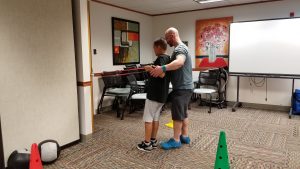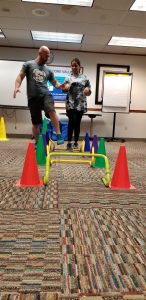“Okay so we’re gonna do squats so what I need you to do is first go to the ball and then feet out and look forward and remember…”
“Hold up. You want to see how I do it?” (coach nods)
“Squat.” (Then I demonstrate the squat)
It’s one of those crossover moments where a coach might find me during a bathroom break and tell me that there are striking similarities between coaching young athletes and coaching athletes with autism. Yup.
We talk about simplification in coaching and there is the constant pull to give more information. The art of coaching, in my experience, is a practice in providing as much verbal information as is useful and absolutely no more. I refer to this process as Label/Demo/Do (LDD).
When I say “Squat” the exercise is labeled. The goal is to have the athlete associate the word with the action. With the autism population, this may take a few dozen practices. With the neurotypical population glued to phone screens, this may take a few dozen practices. Yes, there are some similarities. Performance, whether in activities of daily living or sport, is about independent mastery. I get adamant about labels because I want to be across the room and be able to give directions that are then followed to the best of current ability.
Labeling is pouring concrete; we say it and it sets solid. During our Autism Fitness Certification seminars, attendees will practice coaching a medicine ball push throw. I’ll hear “Good push pass. Do another chest throw. Great chest push throw.” Turkish getups are not from Turkey. Bulgarian split squats were not smuggled out of the Eastern Bloc, but the labels stayed and we have a common language for these exercises. Our athletes, particularly  those with autism and related disorders, need consistency and repetition. A push throw is always going to be a push throw. We should adhere to a Lord of the Rings rule; “One label to rule them all.”
those with autism and related disorders, need consistency and repetition. A push throw is always going to be a push throw. We should adhere to a Lord of the Rings rule; “One label to rule them all.”
Labeling also leads to opportunities for choice and autonomy. If I ask Karl whether he wants to do push throws or overhead throws first, he has a distinct understanding of each exercise. He can demonstrate a preference. For many individuals with autism, this is a highlight of independence and as close to free play as it gets. Because the labels “push throw” and “overhead throw” have been repeated consistently, practiced, and reinforced, Karl can understand the differences and elect his choice.
Introducing exercise is predominantly visual. We can easily show what a movement should look like. A long explanation tends to translate poorly towards performance and takes away from practice time. Demonstrating the exercise allows the athlete to have a visual reference for the movement. Also, some of my athletes genuinely enjoy watching me perform squats. I don’t know why.
Demonstrating is also a great opportunity to set up contingencies or if/then relationships. This is simply translated into “I go, you go.” Our athletes may require a demonstration of a new exercise multiple times during the teaching process. This is much easier and effective than explaining hip position, neutral spine, and every other abstract aspect of movement.
Doing is practice. When our athletes are doing we can assess and address whatever compensations or deviations arise. In the doing phase, we can coach and correct. When our athletes are doing, we can change the variables so that the press is more overhead, the heels are on the floor during squats, and that bear walks don’t deviate into pyramid shuffles (rear up in the air with hands and feet merely gliding across the ground).
Label/Demo/Do is about efficiency. In the 45-60 minutes I have with an athlete (often only 1x/week), I want more time practicing and moving, and less time explaining. Copious amounts of information do not enhance the experience. Here is a very brief example of the LDD method in practice:
Where I will provide robust information is when providing Behavior-Specific Praise (BSP). My favorite concept and practice from the field of Applied Behavior Analysis (ABA), BSP follows the successful completion of a task and illuminates exactly what the individual did successfully. Rather than saying “Great job,” which I could say while staring at the wall, “Great job keeping your feet on the floor” during a push throw tells the athlete that I was watching and reinforces exactly what he/she was doing correctly. There’s a much greater chance they will repeat that behavior after using BSP.
BSP also allows me to give feedback that is descriptive but not overwhelming. When information comes in as instruction, it’s often just noise. When it is praise, there’s a higher chance it will connect with the athlete, neurotypical or otherwise.
The Label/Demo/Do approach seeks to optimize the time spent practicing and refining movement quality. It mitigates the dreaded “stand and wait while coach explains” and enables our athletes to transition quicker. For those working with the autism and special needs population, LDD decreases the opportunity to engage in off-task or problematic behaviors by, in technical terms, giving our athletes something better to do. It takes some practice to say less, but it enables us to coach more.
 Eric Chessen, M.S., is the Founder of Autism Fitness and the Co-Founder of the strength equipment company StrongerthanU.com. Autism Fitness offers certification, online education, and consulting worldwide. For more information visit AutismFitness.com
Eric Chessen, M.S., is the Founder of Autism Fitness and the Co-Founder of the strength equipment company StrongerthanU.com. Autism Fitness offers certification, online education, and consulting worldwide. For more information visit AutismFitness.com

